Combining Two NYC Apartments Into One?
Learn all there is to know about combining apartments in NYC, from regulations and costs to the optimal design-build process.
July 23, 2024
|

Combining Two NYC Apartments Into One?
Combining two NYC apartments can be an enticing option in New York City, but there are many pros and cons to consider beforehand.
Table of contents
- Benefits Of Apartment Combinations In NYC
- Challenges When Combining Two NYC Apartments
- Factors Impacting Costs & Timelines of Apartment Combinations
- How a Design-Build Firm Can Help
- Process & Procedure: Combining Apartments in NYC
- Examples Of Our Apartment Combination Renovations In New York City
Are you considering buying an adjacent apartment for an apartment combination, or purchasing two properties in hopes of combining two apartments into one? Smart move. While not always an immediate option, apartment combinations in NYC can often be the path of least resistance for those requiring more square footage in their Big Apple abode.
In this article, we’ll break down all the nuances of apartment combinations in Manhattan and Brooklyn, including everything from procedures on how we combine two apartments into one and the subsequent financial consideration to the various challenges and opportunities this unique type of apartment renovation in NYC presents. Is combining two apartments better than buying a large apartment? Let’s find out.
[#Benefits]Benefits Of Apartment Combinations In NYC[#Benefits]
COST EFFECTIVE
Combining two apartments is often a better option than buying one large apartment, simply because purchasing and combining an adjacent unit next door is typically more cost effective on a per square foot basis compared to purchasing a new apartment with the already combined square footage. Another way to think about this is that combining apartments is one of the common ways to unlock value in NYC.
PEACE OF MIND
For those New Yorkers dialed into their daily routine, uprooting your entire life to accommodate a home renovation is a tough sell. However, combining two apartments in New York City is an ideal middle ground, offering all the benefits of staying in the same building and neighborhood - while adding space with an upgraded design that suits your lifestyle.
ADDED RESALE VALUE
For those who aren’t looking to move, hearing a neighbor is selling their unit at a bargain — perhaps due to its subpar condition or an estate sale — could make way for a wise investment decision. Knowing that a renovated three-bedroom unit will carry a higher price per square foot than the current unit makes the deal even sweeter.
Washer & Dryer Overruling
StreetEasy confirms only 39% percent of the current listings for sale in Manhattan have washers and dryers. Yet, while many NYC buildings prohibit in-unit laundry, many buildings make exceptions in adjoined units.
Wet & Dry Benefits
Especially in vertical combinations, plumbing and wet over dry restrictions can be less of a concern. In fact, adjusting the plumbing during an apartment combination may be to your benefit. If your building has strict wet or dry restrictions and you're combining two apartments, you may potentially be over someone else's wet space below. In a case of vertical combination the top floor is often unrestricted from a wet over dry restriction since the floor below is also yours.
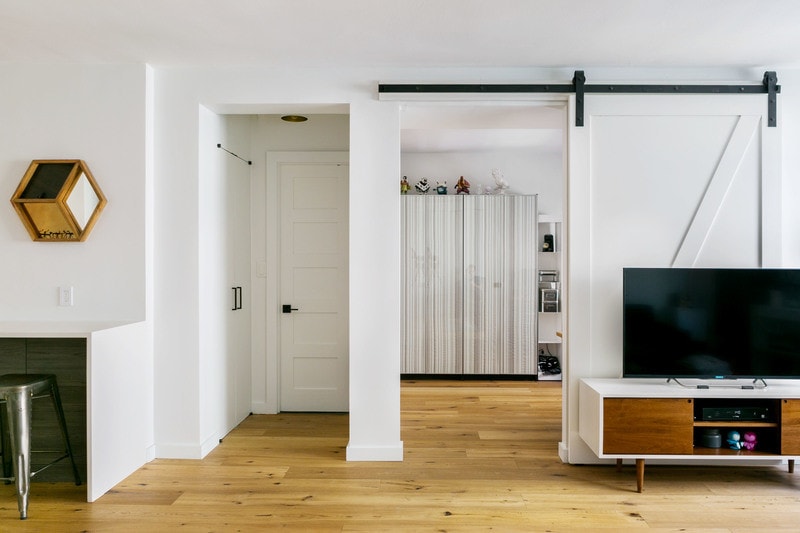
[#Challenges]Challenges When Combining Two NYC Apartments[#Challenges]
Building Board Approvals
Certain buildings have more restrictions than others when combining two apartments in NYC. In condo or co-op combinations, co-op boards need to approve any combination before plans can be filed and permits received. When considering horizontal vs vertical apartment combinations, getting approval for combining two apartments horizontally on the same floor is typically easier than for a vertical combination. If you’re the first in your building trying to join two properties and get approval, you might have a harder time than if others have combined units prior.
Wet Over Dry Restrictions
You can’t count on having the ability to move a bathroom, kitchen, or laundry room to a previously “dry” area, like a closet or living room. Wet over dry areas have the potential to create a liability, which is one of the main reasons projects fail to receive approval. Important to note, however, not all buildings have strict wet over dry restrictions. There are numerous buildings throughout Manhattan with lax wet over dry regulations.
Two Front Doors?
Many - not all - New York City residential buildings do not allow the removal of a unit’s main entry door. When joining two properties, some buildings might allow you to wall off the entry from the inside, but the exterior-facing door usually must remain as part of the respective building’s fire code.
Pro Tip: Having 2 entrances may be a benefit in allowing more flexibility in interior staircase dimensions because having an entrance on both floors no longer forces you to comply with DOB rules for staircase dimensions.
[#Factors]Factors Impacting Costs & Timelines of Apartment Combinations[#Factors]
NYC apartment combinations are typically larger projects in scope and involve extended time in the planning and production stage, along with additional costs. On average, combining two apartments into one takes 5-6 months in planning and another 5-7 months in construction, while costs will be determined by three main factors:
Factor 1) Extent Of Floor-Plan Reconfiguration
If you're combining two apartments where, for the most part, the overall space plan is going to remain very close to the current configuration, turning two units into one cohesive living area requires two bare essentials:
- Capping one of the kitchens
- Creating an entry between the two apartments
Those two updates constitute the legal definition of an apartment combination and also present a best case scenario. Most apartment combinations in NYC are not that straightforward. Quite the contrary. Most of the time joining two apartments is extremely complex, because two layouts rarely blend properly without adjustment. For a logical flow to the expanded home, you're essentially forced into moving various walls and configuring a newly-combined floor-plan.
Here comes the next domino. Moving the walls has potential to open up Pandora's box - because now you're rewiring the space. Now we're potentially bound by restrictions that govern wiring in the building. The electrical overhaul, in and of itself, is a significant undertaking.
This is especially true when combining two studio apartments, where space constraints demand extra creativity to avoid an inefficient layout. Studios often have unique design challenges, such as limited storage and compact kitchens, making it essential to rethink spatial planning. If you are considering merging two studios, check out our full guide on studio apartment combinations for tailored insights on maximizing functionality in smaller spaces.
Bottom line, the more adjustments to the floor plan-plan, the longer and more costly your apartment combination.
Factor 2) Pre-Existing Site Conditions
Beyond the likely floor-plan reconfiguration and subsequent electrical work, existing site conditions can also have strong ramifications on an apartment combination in NYC.
For instance, are the floors the same throughout? Are they the same level? What about ceiling heights? Do wall conditions pair properly? Are you planning on moving a bathroom, kitchen, or laundry room to a former “dry” area (EX: living room) in a building where wet over dry restrictions could prevent the move? If these core aspects of the two adjoined apartments are not aligned favorably, expect higher costs and a longer timeline.
Factor 3) Considerations When Combining Co-Op Apartments In NYC
While all NYC apartment combinations need building sign-off, combining co-op apartments in New York City requires an extra layer of approvals before the job can begin, warranting sign-off from the full co-op board. In most cases, co-op boards will allow combining the two co-op apartments into one, but occasionally there can be building-specific stipulations that must be met, whether that be aesthetic restrictions or a recalibration of maintenance fees. In these instances, enlisting a full-service renovation partner who can navigate co-op board conversations with proper expertise ensures your NYC co-op combination doesn’t get derailed before ever getting started.
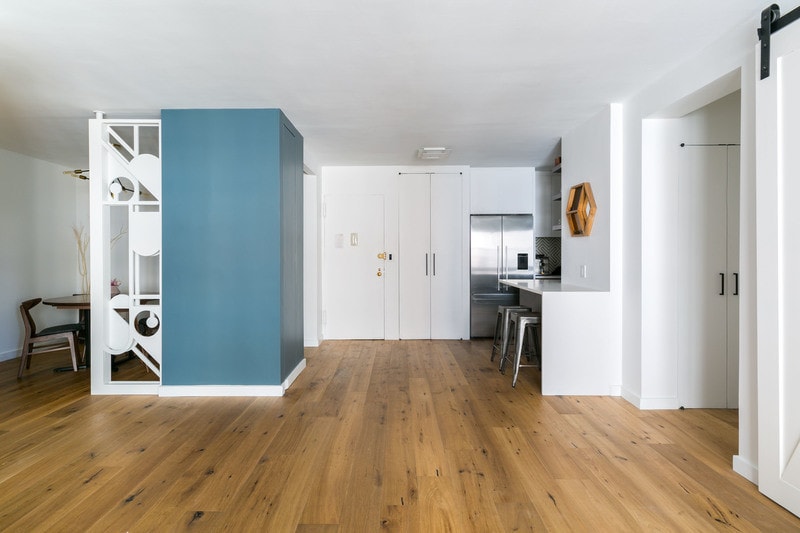
[#Help]How a Design-Build Firm Can Help[#Help]
Apartment renovations in NYC already involve tons of moving parts, so as you can imagine, combining two apartments into one only adds further complication. There’s added spatial planning and twice the design required, meaning more material selection and longer procurement. Plus, added approvals and construction precautions. To supervise the various moving parts and ensure everything lines up literally and figuratively, consider the services of a full-service design-build firm with expertise in apartment combinations, like Gallery KBNY.
All Services Required Managed Under One Roof
The most effective way to organize and manage a project of this scope is to centralize all components required — and that’s exactly where Gallery brings the most value to our customers. For all of our residential renovations, we handle every part of the process, from start to finish. Here are the services our NYC apartment combinations include:
Architecture Services
When considering the architecture services involved in a design-build firm model, our in-house renovation architect starts by understanding the client's goals and creating an optimal layout and design. They handle all architectural drawings, floor-plan reconfigurations, blueprints of the apartment combination, and necessary filings with the NYC Department of Buildings. The process includes detailed digital renderings of the final design, providing a clear visual representation of your completed NYC apartment combination before work even starts.
This fully-integrated architecture design-build process simplifies the renovation process and aligns all aspects of the project under one roof, focusing their efforts specifically on your design goals, based around a predetermined budget and timeline established at the outset of the process. This approach is quite different from hiring a traditional independent architect, where your input may be minimal and your costs may be excessive, as materials are typically 50-100% more expensive when aiming for the true one of a kind appeal an independent architect seeks. For a more detailed comparison of the two approaches, read What Kind Of Architect Is Best For Your NYC Apartment Renovation?
Interior Design Services
Choosing a design-build firm over an individual interior designer offers several benefits. In our model, the interior design of your combined apartments is driven by our in-house interior designer. They handle initial planning and material selection while overseeing procurement and installation, working with our architect, liaisons and construction managers throughout the process to ensure all designs are cohesive and functional. This all-inclusive service provides a smoother and more integrated renovation, which is vital when combining two apartments into one and bridging the gap between two previously distinct designs.
Board Approval And Permitting Services
Design-build firms take on the responsibility of handling all red tape involved in apartment combinations. This includes reviewing and satisfying the alteration agreement, filing all relevant architectural plans with the Department Of Buildings, and procurement of all necessary permits. We also handle all LPC approvals and requirements. In addition, we also fully take on the approval process with the building management company and co-op board. Read more about our board approval and permitting services.
Construction And Renovation Site Management Services
The lynchpin of our design-build process are our project managers, who handle construction and renovation site management services. By working together with our architects and designers, they create customized project plans tailored to clients' unique needs and requirements, while also addressing the many logistical and regulatory challenges that arise when combining two apartments into one. Between initial site assessments, detailed project plans, risk assessments associated with blending properties, compliance checks, and consistent management of the workforce, our project managers ensure your NYC apartment combination is executed to exceed expectations.
Transparent Costs, Delivered Up Front
Design-build firms offer a distinct advantage by providing comprehensive project estimates, including construction management fees, before any contract is signed. This proactive transparency ensures clients understand the full cost from the outset. This is unlike traditional design-bid-build contractors or independent architects, who typically reveal full costs only mid-way through the process, once all design and architectural components are considered and additional sub-contractors are brought into the equation. More transparency up front means less stress throughout what is already going to be a challenging process.
Meticulous Planning to Prevent Surprises
Design-build firms further differentiate themselves with their proactive approach to project planning. With a team that conducts thorough site assessments, crafts detailed schedules, and anticipates all potential hurdles, these all-inclusive firms minimize the risk of unexpected delays. In contrast, traditional contractors often face unforeseen complications mid-project, leading to disruptive change orders and further budget overruns. Design-build firms' meticulous planning ensures a smoother, more predictable renovation experience - which is key when taking on a project significant as an apartment combination in NYC.
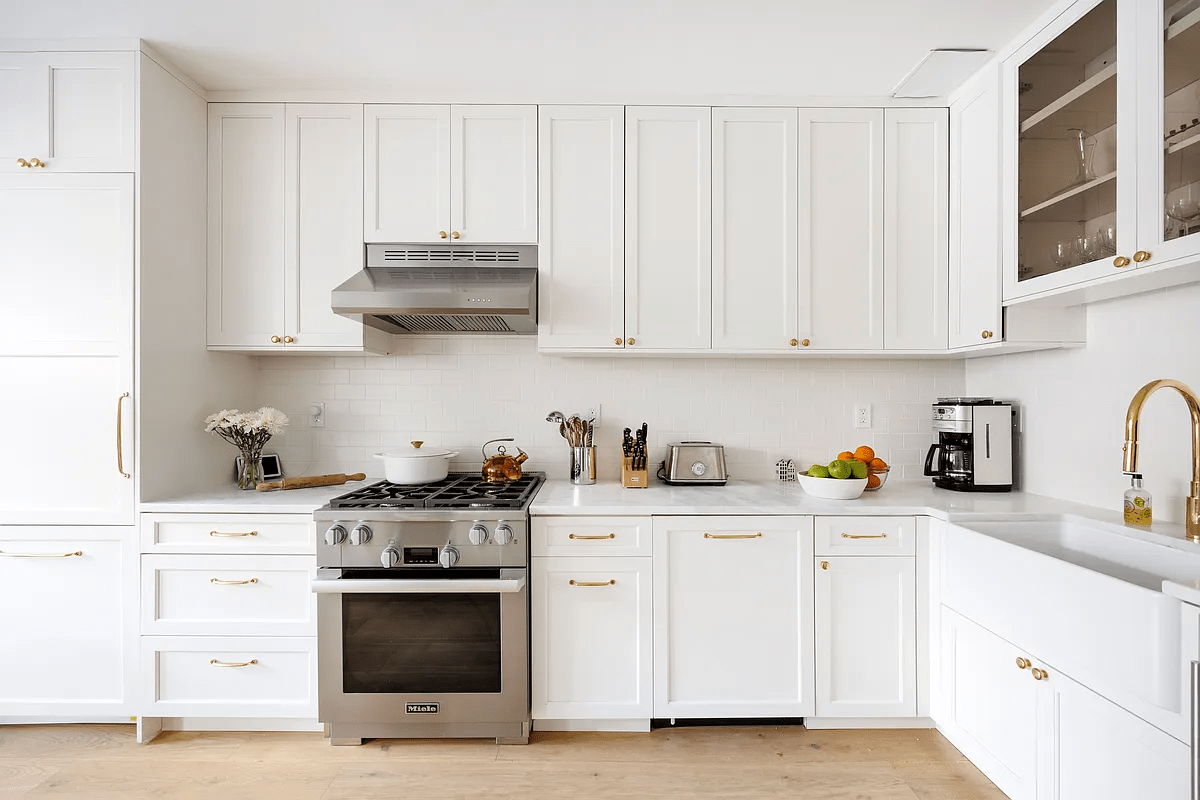
Permits & Approvals For Apartment Combinations In NYC
Depending on the scope of the NYC apartment combination, permits must be obtained from the city or local government. This can include permits for electrical, plumbing, and structural work, as well as permits for any exterior changes or additions. Additionally, various levels of paperwork must be obtained and fulfilled prior to any construction.
Compliance & Certificate Of Occupancy
When drafting the plans for our combined apartments, we make sure to maintain the same square footage as the previous two apartments. This ensures we adhere to the Multiple Dwelling Law, which states combining apartments can reduce the number of families without increasing building size. Additionally, as long as the square footage of the combined apartment remains same as the previous two apartments, a new certificate of occupancy is not required.
DOB Forms
In order to get sign-off from the NYC Department Of Energy, we must submit PW1 (Plan/Work Approval), PW3 (cost estimate), and TR1 (inspections).
Technical Documents For Condo & Co-Op Combinations
When combining two condos or co-ops in NYC, a new tentative tax lot number from the Department of Finance should be obtained before the renovation begins. This process is part of the initial administrative steps to ensure that the newly combined unit is properly recognized for tax and legal purposes. It helps in accurately documenting the changes in property configuration and ensures compliance with regulatory requirements throughout the renovation process.
Approval Process
Plans must be signed-off by a professional engineer or registered architect, which Gallery enlists in-house. Upon finalizing the apartment combination in NYC, our architect also submits the completion letter confirming no new Certificate of Occupancy is necessary.
Building Code
All apartment combinations in NYC require an Alteration Type II permit, allowing for the following alterations:
- Combining apartments on the same or adjacent floors with interior stairs
- Maintaining or reducing zoning rooms
- Meeting natural light, air, and exit requirements
- Removing second kitchens, unless repurposed
Energy Code
All renovations must adhere to energy efficiency guidelines, along with building-specific energy guidelines.
Fire Code Approvals
NYC Fire Department approval may be required if fire code requirements are being adjusted.
Sound overwhelming? No worries. At Gallery, we handle all of the challenging formalities associated with combining two apartments into one on behalf of our clients, as part of our all-inclusive design-build process.

[#Process]Step-By-Step Process For Apartment Combinations In NYC[#Process]
Combining apartments in NYC requires a strategic approach from the outset, only achieved by getting a true understanding of the client’s unique vision and financial parameters. This foundational understanding sets the stage for comprehensive collaboration from day one, where we work closely with clients to explore the practical possibilities of their project in hopes of forming a mutually beneficial partnership.
Our Process | feasibility & Concept design
Phase 1 - Intro Phone Call
Prior to signing any contracts, our team gets an understanding of the client’s goals and budget for their planned NYC apartment combination.
Phase 2 - Site Meeting
After that preliminary consultation, we assess the potential project up-front and on-site with the client.
Phase 3 - Concept Design And Project Budget
If the project appears feasible, our design team and architect deliver an initial concept design, which guides the projected budget and timeline on our formal proposal.
If our design strategy and proposal are agreeable, we kick off our pre-construction and interior design process of our NYC apartment combination process.
Our Process | Pre-Construction & Formal Design
Before any walls are knocked down, our project managers survey the site and build timelines for your NYC apartment combination according to client goals, while all structural adjustments are considered by the architect and accounted for in an updated blueprint.
As the plans are built and awaiting approval by all parties, our designers are working in tandem with clients to fulfill their design dreams, streamlining material confirmations to our liaisons for procurement.
Phase 1 - Inspections, Diagnostic Testing & Risk Management
While we can often identify many potential surprises ahead of time during our initial walk-throughs, a more thorough phase of inspections must take place to verify all internal elements are equipped for the upcoming combination of apartments, probing walls and bringing specialized contractors for sign-offs.
Phase 2 - Formal Design & Material Procurement
Whether sourcing on-site from a showroom or drawing inspiration from your mood board, our design process for apartment combinations is catered to our clients’ needs in every way possible.
Phase 3 - Building Submission
Formal submission is required to ensure respective building codes and energy codes are met upon combination of two apartments.
Phase 4 - DOB Submission, Approval & Permits
Since apartment combinations in NYC are far from the norm, the associated approvals and permits tend to be more complicated. For co-op combinations, this process also requires obtaining a tentative tax lot number from the Department of Finance.
Phase 5 - Production Calendar & Logistics
Once plans are approved by all parties and all designs have been signed off by the client, the production calendar can be put into motion and production can begin.
Our Process | Production
When combining two apartments in NYC, the production is considerably more complicated than the average renovation. Yet, when properly planned, the execution becomes streamlined and considerably more efficient. Below are the components of our production process:
- Demolition Of Both Apartments
- Initial Inspections
- Framing & Rough Carpentry
- Electrical & Plumbing
- Delivery Of Finishes And Fixtures
- Finish Carpentry & Installation Of Finish Fixtures
- Final Inspections & Walk-Throughs
- Close Out Of Permits, Completion Letter, And Sign-offs
[#Examples]Examples Of Our Apartment Combination Renovations In New York City[#Examples]
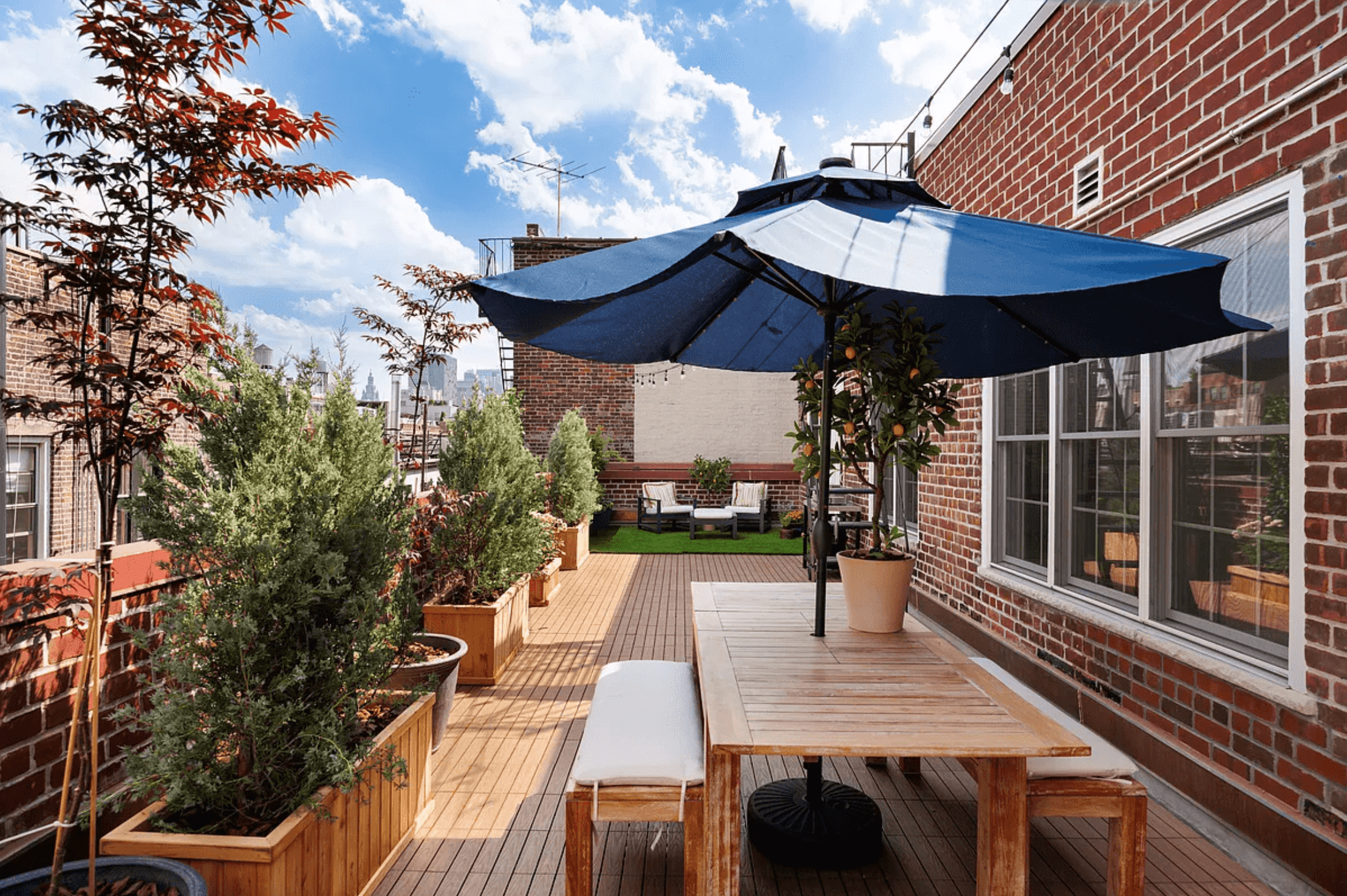
Co-Op Apartment Combination Gut Renovation In Greenwich Village | 180 Thompson St
Our client originally purchased a one bed, one bath co-op in a seven-story building in Greenwich Village. Years later, another one bedroom sponsor unit became available next door, which he purchased in hopes of an apartment combination. The goal was to create a more spacious apartment with two bedrooms and two bathrooms, while also combining the two outdoor deck spaces each unit offered. To accommodate, we fully gut renovated both spaces (with the exception of one recently-updated guest bathroom), then combined the two apartments to create an immersive and elegant home that allowed him to settle into his post-bachelor life with added comfort and desirability. View the full apartment renovation before and after.

Pre-War Apartment Combination In Greenwich Village | 23 E 10th
Look up The Albert building in New York City and you’ll find a rich history, as the famed Greenwich Village hotel-turned-apartment complex has been graced by everyone from Jim Morrison to James Taylor. That rich history resonated amidst this NYC apartment combination for a young family who purchased two units in the historic building in hopes of combining two apartments into one with a more modern and engaging layout. View the full renovation via our before and after.
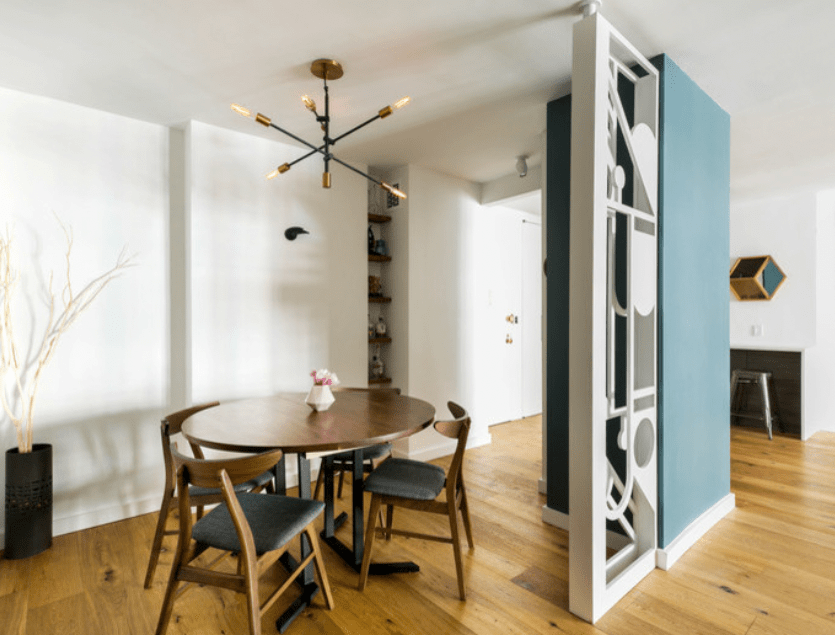
Apartment Combination In Upper West Side Manhattan | 30 West 60th
This NYC apartment renovation project in a Columbus Circle co-op involved the horizontal combination of an existing one bedroom apartment with a newly purchased one bedroom unit next door. As is common with almost any project involving the adjoining of two apartments, the scope of construction included work being done in both units to ensure a uniform floor and ceiling height and the integration of the electrical system. View the full renovation via our before and after or the rest of our portfolio of NYC apartment combination before and afters.
Conclusion
If you’re planning a renovation that involves combining two apartments into one in New York City, learn more about what separates a fully-integrated design-build firm like Gallery KBNY from would-be alternatives, view our apartment renovation before and after portfolio, or contact us to see why our New York City apartment renovation and remodeling services are the most mindful choice when choosing a home renovation contractor in NYC.

.png)
.png)



.jpg)

.jpg)

%20(2).jpg)


.jpg)
%20Gallery%20KBNY.JPG)


